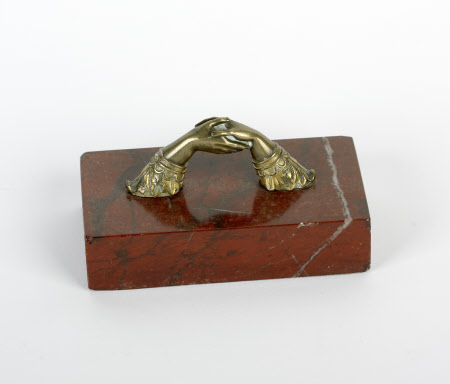A paperweight with a handle in the form of clasped hands
French School
Category
Art / Sculpture
Date
c. 1820 - 1850
Materials
Bronze, Marble
Measurements
63 x 63 mm; 120 mm (L)
Order this imageCollection
The Argory, County Armagh
NT 565220
Summary
Sculpture, marble and bronze; a paperweight with the handle in the form of two clasped hands; French; c. 1820-1850. The smaller of two similar paperweights at the Argory that employ the motif of clasped hands, popular in the nineteenth century as a symbol of union and fidelity.
Full description
A paper-weight in the form of a rectangular red marble block, into the centre top surface of which is inserted a bronze handle, in the form of two clasped female hands, each emerging from an identical sleeve with acanthus leaf decoration and with a slim cuff with punched decoration and a scalloped edge. This is the smaller of two paperweights of different sizes at the Argory that employ for their handles identical pairs of joined hands (the other is NT 565219). They must have been made in the same French workshop, probably around the second quarter of the nineteenth century. Similar paperweights with the same bronze hands appear periodically with French antique dealers, for example one recently with Desarnaud in Paris, in which the sleeves of the hands were gilded. In another one sold at auction in 2018 (Osenat, Fontainebleau, Mobilier & Objets d'Art, 1 April 2018, lot 52), the hands were entirely gilded, and there was also a ring on the first finger. The act of two people joining their right hands (‘dextrarum iunctio’) dates back as far as Roman times as a symbol of union in marriage. Roman stelae or funerary tablets often show couples clasping their hands in this way, as a symbol of their hopes for reunion in the afterlife. The symbolic act continued in use into the early modern period as part of the marriage ceremony, usually in conjunction with the cleansing of hands in a basin of water. In the paperweights at the Argory, well-made but routine functional objects, the joining of two women’s hands is likely at this period in the nineteenth century to have at most been intended to symbolise the virtues of close friendship. Nevertheless, in nineteenth-century Europe, sculptures or, more usually, casts of hands enjoyed renewed popularity, both as distillations of the genius of illustrious people, but also as symbols of love. A good example of the former is the plaster cast of the hands of Thomas Carlyle (1795-1881) by Sir Joseph Edgar Boehm (1834 -1890) at Carlyle’s House (NT 263813), whilst at Smallhythe Place there are plaster casts of the hands of the dancer Eleonora Duse (NT 1118509) and of the hands of Dame Ellen Terry (NT 1118535). The most celebrated nineteenth-century sculpture of hands used to convey a message of love and friendship is that of the joined right hands of the two poets, Robert Browning (1812-1889) and his wife Elizabeth Barrett Browning (1806-1861), by the American sculptor Harriet Hosmer (1830-1908), made by Hosmer in 1853 from a life cast take from the sitters' hands (Fein 2019). Jeremy Warren November 2022
Provenance
By descent; Walter McGeough Bond (1908-86), by whom given to the National Trust in 1979.
Makers and roles
French School, sculptor
References
Fein 2019: Katherine Fein, ‘“The Sense of Nearness”: Harriet Hosmer’s Clasped Hands and the Materials and Bodies of Nineteenth-Century Life Casting’, British Art Studies, Issue 14 (2019), https://dx.doi.org/10.17658/issn.2058-5462/issue-14/kfein
